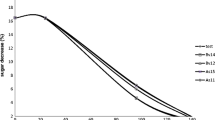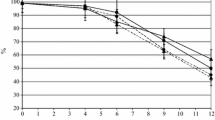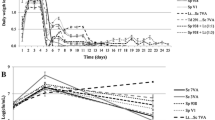Abstract
The aim of this work was to evaluate the suitability of four strains of Saccharomyces cerevisiae endowed with in vitro β-glucosidase activity to improve the Sangiovese wine aroma profiles. In particular the effects of the strains on fermentation kinetics, wine sugar and acid concentrations, volatile molecule profiles and colour parameters were evaluated. Moreover their effects on anthocyanins, anthocyanidins and poliphenols were evaluated. These four strains of S. cerevisiae were tested in comparison with one commercial strain and with a spontaneous fermentation in the presence and in the absence of paraffin oil. The results showed that the four wild strains had high fermentation rates and an efficient conversion of grape sugars to alcohol. However, each strain imparted specific features to the wine. AS11 and AS15 gave rise to wine having low volatile acidity values associated to high levels of linalool and nerolidol. They provoked decrease of anthocyanins accompanied by the increase of some anthocyanidins. S. cerevisiae BV12 and BV14 showed the best performances producing wines with the lowest residual sugar contents and volatile acidity values, high levels of nerolidol and citronellol without detrimental effects on wine colour.

Similar content being viewed by others
References
Blom H (1983) Partial characterization of a thermostable anthocyanin-β-glycosidase from Aspergillus niger. Food Chem 12:197–204
Caridi A (2007) New perspectives in safety and quality enhancement of wine through selection of yeasts based on the parietal adsorption activity. Int J Food Microbiol 120:167–172
Castellari M, Arfelli G, Riponi C, Amati A (1998) Evolution of phenolic compounds in red winemaking as affected by must oxygenation. Am J Enol Vitic 49(1):91–94
Castellari M, Versari A, Spinabelli U, Galassi S, Amati A (2000) An improved HPLC method for the analysis of organic acids, carbohydrates and alcohols in grape musts and wines. J Liquid Chromat Rel Technol 23:2047–2056
Ciani M, Beco L, Comitini F (2006) Fermentation behaviour and metabolic interactions of multi-starter wine yeast fermentations. Int J Food Microbiol 108:239–245
EC (2000) Community reference methods for the analysis of spirits drinks. Official Journal of the European Community (Reg EC No 2870/00. 19 Dec, Brussels)
Egli CM, Ediger WD, Mitrakul CM, Henick-Kling T (1998) Dynamics of indigenous and inoculated yeast populations and their effects on the sensory character of Riesling and Chardonnay wines. J Ind Microbiol Biotechnol 85:779–789
Fia G, Giovani G, Rosi I (2005) Study of β-glucosidase production by wine-related yeasts during alcoholic fermentation. A new rapid fluorimetric method to determine enzymatic activity. J Appl Microbiol 99:509–517
Fleet GH (1997) Food microbiology, fundamentals and frontiers. In: Doyle MP, Beuchat LR, Montville TJ (eds) Wine. American Society for Microbiology, Washington DC, pp 671–694
Glories Y (1984) La coleur des vins rouges: 11 partie. Les equilibres des anthocyanes et des tanins. Connaiss Vigne Vin 18:195–217
Glories Y (1999) Metodi di analisi del colore e di alcuni indici sui composti fenolici. Vignevini 3:51–54
Günata Z, Dugelay L, Sapis JC, Baumes R, Bayonove C (1990) Action des glycosidases exogenes au cours de la vinification: Liberation de l’arôme à partir de précurseurs glycosidiques. J Intl Sci Vigne Vins 24:133–144
Henschke PA (1997) Yeast sugar metabolism: biochemistry, genetics, biotechnology and applications. In: Zimmermann FK, Entian KD (eds) Wine yeast. Technomic, Lancaster, pp 527–560
Hernàndez LF, Espinosa JC, Fernàndez-Gonzàlez M, Briones A (2003) ß-Glucosidase activity in a Saccharomyces cerevisiae wine strain. Int J Food Microbiol 80:171–176
Holm Hansen E, Nissen P, Sommer P, Nielsen JC, Arneborg N (2001) The effect of oxygen on the survival of non-Saccharomyces yeasts during mixed culture fermentations of grape juice with Saccharomyces cerevisiae. J Appl Microbiol 91:541–547
Li H, Tao YS, Wang H, Li Z (2008) Impact odorants of Chardonnay dry white wine from Changli County (China). Europ Food Res Technol 227:287–292
Manzanares P, Orejas M, Ibáñez E, Vallés S, Ramón D (2000) Purification and characterization of an L-rhamnosidase from Aspergillus nidulans. Lett Appl Microbiol 31:198–202
Manzanares P, van den Broeck HC, de Graaff LH, Visser J (2001) Purification and characterization of two different L-rhamnosidases, RhaA and RhaB, from Aspergillus aculeatus. Appl Environ Microbiol 67:2230–2234
Panon G (1997) Influence of oxygen on fermentation pattern in model media containing mixed or sequential cultures of three ciderproducing yeasts: Saccharomyces cerevisiae, Hanseniaspora valbyensis and Metschnikowia pulcherrima. Sci Alim 17:193–217
Patel S, Shibamoto T (2002) Effect of different strains of Saccharomyces cerevisiae on production of volatiles in Napa Gamay wine and Petite Sirah wine. J Agric Food Chem 50:5649–5653
Perez G, Farina L, Barquet M, Boido E, Gaggero C, Dellacassa E, Carrau F (2010) A quick screening method to identify b-glucosidase activity in native wine yeast strains: application of Esculin Glycerol Agar (EGA) medium. World J Microbiol Biotechnol doi: 10.1007/s11274-010-0425-4 (In press)
Ramon-Portugal F, Seiller I, Taillandier P, Favarel JL, Nepveu F, Strehaiano P (1999) Kinetics of production and consumption of organic acids during alcoholic fermentation by Saccharomyces cerevisiae. Food Technol Biotechnol 37:235–240
Rodríguez ME, Lóopes CA, Van Broock M, Vallées S, Ramón D, Caballero AC (2004) Screening and typing of patagonian wine yeasts for glycosidase activities. J Appl Microbiol 96:89–95
Romano P, Fiore C, Paraggio M, Caruso M, Capece A (2003) Function of yeasts species and strains in wine flavour. Food Microbiol 86:169–180
Sánchez-Torres P, González-Candelas L, Ramón D (1998) Heterologous expression of a Candida molischiana anthocyanin-β-glucosidase in a wine yeast strain. J Agric Food Chem 46:354–360
Todaro A, Palmeri R, Barbagallo RN, Pifferi PG, Spagna G (2008) Increase of trans-resveratrol in typical Sicilian wine using β-Glucosidase from various sources. Food Chem 107:1570–1575
Tosi E, Azzolini M, Guzzo F, Zapparoli G (2009) Evidence of different fermentation behaviours of two indigenous strains of Saccharomyces cerevisiae and Saccharomyces uvarum isolated from Amarone wine. J Appl Microbiol 107:210–219
Ubeda Iranzo JF, Briones Pérez AI, Izquierdo Cañas PM (1998) Study of the oenological characteristics and enzymatic activities of wine yeasts. Food Microbiol 15:399–406
Valero E, Moyano L, Millan MC, Medina M, Ortega JM (2002) Higher alcohols, and esters production by Saccharomyces cerevisiae. Influence of the initial oxygenation of the grape must. Food Chem 78:57–61
Vernocchi P, Valmorri S, Dalai I, Torriani S, Gianotti A, Suzzi G, Guerzoni ME, Mastrocola D, Gardini F (2004) Characterization of the yeast population involved in the production of a typical Italian bread. J Food Sci 69(7):182–186
Visser W, Scheffers WA, Batenburg-Van Der Vegte WH, Van Dijken JP (1990) Oxygen requirements of yeasts. Appl Environ Microbiol 56:3785–3792
Winterhalter P, Skouroumounis GK (1997) Biotechnology of aroma compounds, advances in biochemical engineering biotechnology. In: Scheper T (ed) Glycoconjugated aroma compounds: occurrence, role and biotechnological transformation, vol 55. Springer, Berlin, pp 73–105
Author information
Authors and Affiliations
Corresponding author
Rights and permissions
About this article
Cite this article
Vernocchi, P., Ndagijimana, M., Serrazanetti, D.I. et al. Use of Saccharomyces cerevisiae strains endowed with β-glucosidase activity for the production of Sangiovese wine. World J Microbiol Biotechnol 27, 1423–1433 (2011). https://doi.org/10.1007/s11274-010-0594-1
Received:
Accepted:
Published:
Issue Date:
DOI: https://doi.org/10.1007/s11274-010-0594-1




